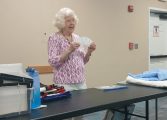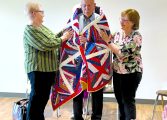“We had Russians who came to a festival and we all learned to say ‘hello’ in Russian, and greeted one young girl as well as two young Russian men who couldn’t speak English but came with an interpreter,” Wise said. “By the end of the evening the Russians and Americans had reached an accord.” The audience responded with smiles and laughter.
He then took the audience to Europe: to French cafés, l’amour, Edith Piaf and “La Vie en Rose.” Then it was on to German beer gardens and polkas. This led to a singalong of the famous song “Edelweiss” from The Sound of Music.
Then Wise went on to the Alps, Austria and Switzerland where men in lederhosen and women in dirndls imitate the mating of grouse flapping their wings in a traditional folk dance. It was in Vienna, Austria, that the accordion was patented in 1829 as a folk instrument, he said.
Italy is famous for introducing the accordion to America through familiar tunes, including “That’s Amore” and “Come Back to Sorrento.” While growing up in Ottowa, Ill., Wise found his attraction for the accordion led him to Carlos Santucci, who taught him as a child. His childhood fascination stayed with him ever since and nowadays, Wise teaches other youngsters accordion masterpieces customary to European cultures.
At the turn of the 20th century, European emigrants traveled with their accordions around the world, eventually bringing their folk music to America where it became popular with Vaudeville audiences and in a variety of musical styles, including zydeco and Cajun, which were popular in Louisiana. Polkas were also popular at the time.
Wise explained that he plays a chromatic piano accordion with keys on one side, buttons on the other and bellows. Some, he said, play the diatonic accordion with buttons on both sides.
Wise admitted his love of the accordion comes from the ability to combine all the complex sounds of music. “With the accordion you have rhythm, melody, harmony plus tone color,” he said.
Wise’s company, Accordion Plus, LLC, repairs and restores accordions and sells them, and is well respected in his field. He restored Flory Jagoda’s 75-year-old Hohner Student III Accordion, a possession that he said saved her life when she fled Nazi-occupied Zagreb, Croatia, in 1941. He told the touching story of Flory, a Jewish girl who was told by her father to get on the train, keep her mouth shut, avoid talking to anyone and just continue playing her accordion. She and her family eventually made it to America. The accordion saved her life, he said.
Wise started a program called Accordions for Kids/USA to promote his enthusiasm for the accordion, to safeguard it for the future, and to protect the culture and customs from becoming relegated to the past. He ended the evening with the rousing polka “Roll out the Barrel,” from the one culture that started it all.




